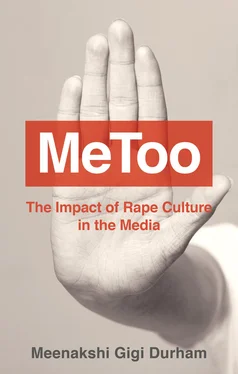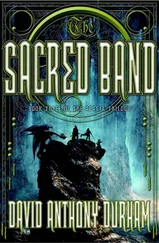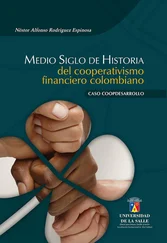In the chapters that follow I will trace the specific strategies and structures of rape culture that harbored and hid sexual predation in the media industries, silencing the capacity of survivors to disclose their assaults. Delving into these processes requires a multifaceted analysis of the media environment: the workplace conditions that condone and conceal sexual violence, but also the mediated representations and images through which rape culture is circulated and interpreted and the ways in which the media—especially social media—have become a catalyst for silence breaking and for feminist activism against rape culture.
To think about media culture in this way frames it as a social apparatus in the sense defined by Michel Foucault: as an assemblage of interconnected images, discourses, laws, policies, philosophies, and other forms of social knowledge that operate strategically in the service of power. 17Sexuality is, for Foucault, “a domain saturated with power,” 18constructed through mechanisms such as religion, law, or the media, all of which claim to offer the “truth” about sex and thereby exert control over its meaning. The media are saturated with sex, as well as with sexual violence. In this book I explore how the media environment serves as a prime conduit for both silencing and silence breaking around rape culture.
Understanding the media environment involves paying close attention “to the production of culture, to the [media] texts themselves, and to their reception by the audience.” 19In conformity with this logic, the present book is divided into three chapters that address different facets of rape culture in the media, especially in terms of silencing and silence breaking. My starting point in chapter 1is US media corporations, as these were the epicenter of the revelations that fueled the global spread of #MeToo and the current engagements with rape culture. Scrutinizing the media corporations in which rape culture ran rampant yet was deliberately hidden from view provides insight into the institutional framework of sexual predation at work. To say this is not to presume, blithely, that the way things happened at Fox News or in the Weinstein Company can be mapped directly onto a meatpacking plant in Iowa or a casino in Macao, even though those workplaces are just as likely to abet sexual violence. Plainly, that would be too easy a leap. But there is also evidence, given the rise of #MeToo/MeToo movements globally, that the sexual predation exposed in Hollywood and New York bridged systems and structures of workplaces in the United States and around the world. Sandra Pezqueda, a working-class Latina woman, observed in TIME magazine: “Someone who is in the limelight is able to speak out more easily than people who are poor. The reality of being a woman is the same—the difference is the risk each woman must take.” 20Those differential risks are, of course, significant; the life consequences—financial, familial, physical—are much greater and potentially more calamitous for poor women, women of color, lesbian women, transwomen.
This is even more alarming in light of the uptake of rape culture and endorsement of sexual violence, particularly against women, at the highest levels of political power, in parallel with the global rise of despotic populism.
The second chapter shifts the focus from organizational structures to media content, examining how rape culture has been systemically incorporated, resisted, and reinforced through representations, from pornography and sexual cybercrimes to news reporting. Some of these representations preceded and gave rise to the MeToo moment, some coincided with it and energized it, and some unfolded after #MeToo made its mark; some functioned to reassert silencing strategies, while some reinforced the structures that consolidate rape culture. My analyses center on forms of media that have had a global impact, from revenge porn to the work of the Boston Globe ’s investigative “Spotlight” team.
The third chapter takes up the backlash against MeToo/#MeToo that has arisen after the hashtag went viral and runs from accusations of a “witch hunt” to intersectional critiques that challenge the movement’s whiteness and its links to criminal justice systems that oppress marginalized and minoritized communities. These provocations and perceptions are important to the evolution and constant metamorphosis of MeToo and to the breaking of silences around rape culture.
The Brazilian educator and philosopher Paulo Freire writes of a “culture of silence” in situations of domination, where subordinate groups are rendered mute by those in power. Breaking this enforced and subjugating silence will, he believes, create the conditions for the oppressed to enter into dialogue with the oppressors, so that together they may create a vision for collective social change. 21
#MeToo/MeToo called out the “culture of silence” that rape culture has imposed for centuries on sexual violence survivors. The silence has been broken. For all the ambivalences, tensions, and confrontations of the “MeToo moment,” by breaking the silence, we are beginning to see our way toward transforming a rape culture.
The MeToo/#MeToo movement’s core concern is for survivors of sexual abuse, assault, and harassment, in the workplace as well as in other spaces and places. The term “survivor” has largely displaced “victim” in feminist writings on sexual assault; this is a consequence of the feminist conviction that those who experience sexual violence are never responsible for its occurrence. The sociologist Liz Kelly argued for the need to shift “the emphasis from viewing victims as passive victims of sexual violence to seeing them as active survivors.” 22While I concur completely with this view and support attributing to survivors of sexual abuse the overtones of courage, self-determination, and strength that attend the term “survivor,” I find power in the term “victim” as well: the fact of victimization calls out the reality of a perpetrator, an assailant who deliberately sexually violated and harmed another being. “Survivor” seems to move past the harm done by the assault; “victim” re-centers it. In addition, not all people who are sexually attacked survive. In this book, while I use the term “survivor” most of the time, I use the word “victim” as well, not with a pejorative sense but to honor the fact that sexual violence causes harm and trauma. Sometimes I use “victim-survivor.” This terminology speaks to my efforts to balance the recognition of survivors’ spirit and strength with the real pain and injury of sexual violence, more clearly conveyed by “victim.”
I have also grappled with how best to refer to the wide-ranging types of sexual violence that fall under the MeToo/#MeToo umbrella: catcalls and other forms of verbal harassment, unwanted touching, coercion, violent attacks, rape with objects, and the like. Legal definitions of “rape,” “sexual abuse,” “sexual battery,” “sex offense,” “harassment,” and so on are specific and distinct, varying from state to state and from country to country and carrying with them particular penalties. As I am not engaging in a formal legal analysis, the terms I use refer to commonly understood behaviors. One of the critiques of the #MeToo movement is its alleged lack of discernment about the differences between these behaviors, a critique that implies that some are less serious than others. The feminist journalist Jamie Utt calls this approach “perpetrator logic,” as it discounts the survivor’s experience of the impact of a sexual violation. 23She rejects the notion of a continuum of sexual violence on a scale from negligible to serious and conceptualizes sexual violence instead as comprising “a matrix of intersecting behaviors” that can occur simultaneously and are all used to harm the victim. Similarly, Liz Kelly decades earlier pointed to “a basic common character” underpinning various forms of sexual violence. 24
Читать дальше












